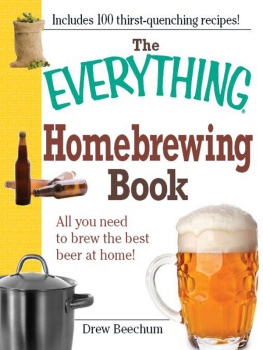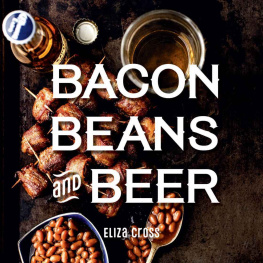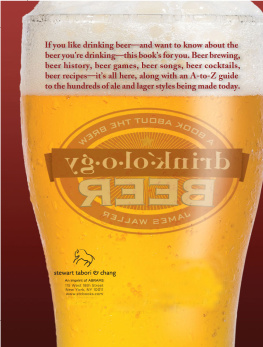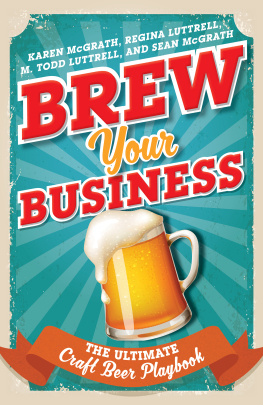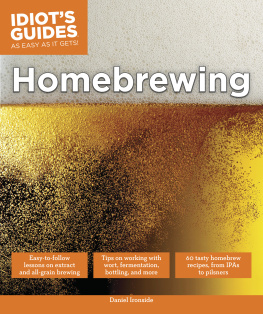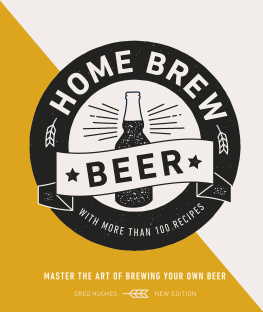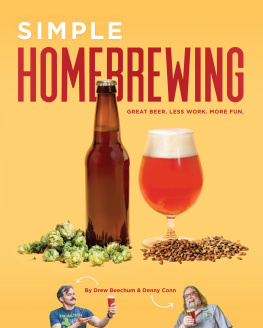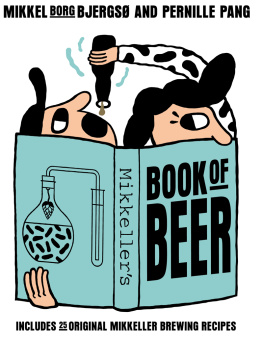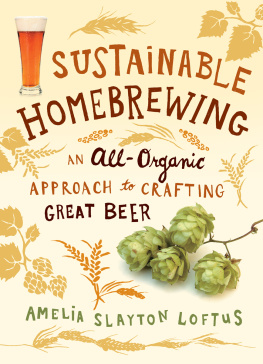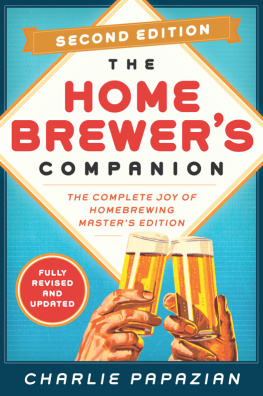MAD SCIENCE IN THE PURSUIT OF GREAT BEER
EXPERIMENTAL
HOMEBREWING
BY DREW BEECHUM AND DENNY CONN

First published in 2014 by Voyageur Press, an imprint of Quarto Publishing Group USA Inc., 400 First Avenue North, Suite 400, Minneapolis, MN 55401 USA
2014 Quarto Publishing Group USA Inc.
Text Drew Beechum and Denny Conn
All rights reserved. With the exception of quoting brief passages for the purposes of review, no part of this publication may be reproduced without prior written permission from the Publisher.
The information in this book is true and complete to the best of our knowledge. All recommendations are made without any guarantee on the part of the author or Publisher, who also disclaims any liability incurred in connection with the use of this data or specific details.
We recognize, further, that some words, model names, and designations mentioned herein are the property of the trademark holder. We use them for identification purposes only. This is not an official publication.
Voyageur Press titles are also available at discounts in bulk quantity for industrial or sales-promotional use. For details write to Special Sales Manager at Quarto Publishing Group USA Inc., 400 First Avenue North, Suite 400, Minneapolis, MN 55401 USA.
To find out more about our books, visit us online at www.VoyageurPress.com.
Digital edition: 978-1-62788-490-7
Softcover edition: 978-0-7603-4538-2
Library of Congress Cataloging-in-Publication Data
Beechum, Drew.
Experimental homebrewing : mad science in the pursuit of great beer / by Drew Beechum and Denny Conn.
pages cm
ISBN 978-0-7603-4538-2 (paperback)
1. Beer. 2. Beer--Flavor and odor. 3. Brewing. I. Conn, Denny. II. Title.
TP577.B363 2014
641.23--dc23
2014014497
Acquisitions Editor: Thom OHearn
Project Manager: Elizabeth Noll
Design Manager: James Kegley
Cover Designer: Nick Zdon
Layout Designer: Karl Laun
Layout: Diana Boger
Photo credits:
Eric Gaddy: frontis and pages, 1,
Diane Griffin: Pages (right)
Charlie Essers: Page (left)
Anna Hoychuk, 209 isak55
JJRD
CONTENTS
Italics indicate a recipe
Introduction
CLOSE YOUR EYES FOR A MOMENT and picture the classic mad scientists lab: bubbling beakers, electricity arcing through the air, thunder crashing on a dark and stormy night. A wild-eyed, white-frocked man is at work bringing his newest creation to lifehe zips around the lab with the excitement of discovery.
Now open your eyes. Do you get this feeling when you brew? Its okay. We arent sizing you up for a padded cell. We feel the same way. In fact, were obsessive when it comes to unlocking the secrets of beer and stumbling upon the next great discovery. New flavors! New sensations! One day, theyll see our true genius! Well show them!
Ahem sorry about that. Its hard not to get carried away when you get us going about homebrewing. If youre just beginning to brew or havent yet begun, oh are you in for a treat. Some of the stuff we talk about will seem bewildering, but dont worry. There are great beginners books out there to help you master the basics (see ). In this book, weve tried to create a companion to those books, a book that will help you on your way from ordinary brewer to accomplished mad scientist.
For those of you who brew but go into a cold, sweaty panic when you hear the word science, dont worry. You wont find us breaking out anything more complicated than what was available to the average brewery of pre-Prohibition times. The idea is to try new stuff, decide if it makes beer that you like, and go from there. Really, were all about getting a chance to play and learn in the brewhouse.
ABOUT OUR PROCESS
When we first sat down and debated what this book was going to look like, we spent a lot of time talking about our brew day processes. In other words, how should we look at Dennys techniques for brewing a world-famous bourbon vanilla porter or Drews constant twists and turns on a familiar style, like saison?
As we sat and pondered our successful beers, we realized the weird and wacky side of things only worked due to some reasoned experimentation. We can talk endlessly about the strange ideas we have, but the success with a recipe always comes back to the trial and error. It comes back to the experiment.
Merriam-Webster defines an experiment as an operation or procedure carried out under controlled conditions in order to discover an unknown effect or law, to test or establish a hypothesis, or to illustrate a known law. For scientists, an experiment is an attempt to answer a question. This is where the vaunted scientific method, oft-misunderstood cornerstone of the modern world, comes into play. The method consists of a series of steps that the experimenter must follow for it to be an official experiment:
Question: What is the question youre seeking to answer?
Hypothesis: What do you think the answer is? You must be able to prove your hypothesis true or false.
Prediction: How will you know that your hypothesis is right or wrong?
Test: This is your experiment.
Review and analysis: Look at your results and see whether your hypothesis is true or false based on your data.
Now lets apply the scientific method to brewing. Perhaps we want to find out if late-hop-only (hop-bursted) beers exhibit the same bitterness as traditionally hopped beers:
Question: Do late-hop-only beers exhibit the same bitterness as traditionally hopped beers?
Hypothesis: Beers with only late additions will have a noticeably less bitter flavor than beers bittered to the same calculated international bittering units (IBUs) with a start-of-boil bittering charge.
Prediction: The less bitter beer will be discernible in a taste test focused on evaluating bitterness.
Test: Brew two beers from one mash. One boil kettle will get a standard 60-minute addition with enough alpha acid units (AAUs) to create 30 IBUs. The second boil kettle will get a late-hop-only charge at 5 minutes with enough AAUs to create 30 IBUs.
Review and analysis: Does a blind triangle tasting confirm the hypothesis? How many judges got it correct? What were their comments?
This may seem pretty straightforward, but the details can sink any experiment. For instance, if we change the word flavor in the hypothesis to level, then it calls into question the prediction. What does level mean? A quantified IBU? Great! But that would require fancy equipment to measure. On the other hand, flavor allows us to use a taste test. And in the end, isnt that what you care about?
In the professional world, scientists spend countless hours designing and redesigning their experiments to make sure that what theyre testing is what they think theyre testing. It takes weeks of careful strategizing for scientists to make sure theyve got the right plan in place. On the other hand, the experimentation that well be doing is going to be simple kitchen sciencewithout the rigorous controls and designs that are required if youre releasing, say, a cancer treatment. Its somewhat scientific, but its not Science with a capital


